
Rosaceae, the rose family, is a medium-sized family of flowering plants, including 4,828 known species in 91 genera.
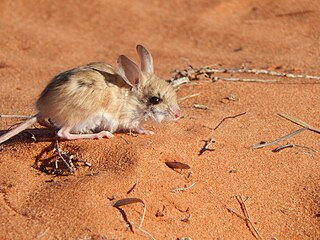
The dusky hopping mouse, is a small rodent endemic to Australia, inhabiting desert regions characterised by sand dunes. Populations have experienced significant declines since the arrival of Europeans, and continue to be subject to threatening processes. It is currently listed as a threatened species.
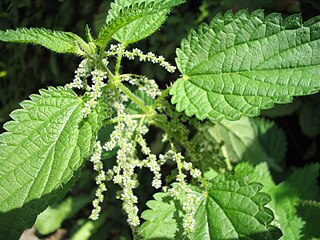
The Urticaceae are a family, the nettle family, of flowering plants. The family name comes from the genus Urtica. The Urticaceae include a number of well-known and useful plants, including nettles in the genus Urtica, ramie, māmaki, and ajlai.

Hevea brasiliensis, the Pará rubber tree, sharinga tree, seringueira, or most commonly, rubber tree or rubber plant, is a flowering plant belonging to the spurge family Euphorbiaceae. It is the most economically important member of the genus Hevea because the milky latex extracted from the tree is the primary source of natural rubber.

Mallotus is a genus of the spurge family Euphorbiaceae first described as a genus in 1790. Two species are found in tropical Africa and Madagascar. All the other species are found in East Asia, the Indian Subcontinent, Southeast Asia, eastern Australia, and certain islands of the western Pacific. The genus has about 150 species of dioecious trees or shrubs.
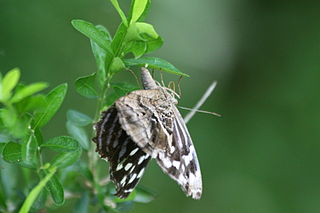
Adelia is a genus of flowering plants in the spurge family, Euphorbiaceae, subfamily Acalyphoideae. It is native to Latin America and the Caribbean, with one species extending northward into the southernmost part of Texas.
Melanolepis is a plant genus of the family Euphorbiaceae, first described as a genus in 1856. It is native to Southeast Asia, New Guinea, and some islands of the western Pacific.
- Melanolepis multiglandulosa(Reinw. ex Blume) Rchb. & Zoll - Nansei-shoto, Mariana Islands, Solomon Islands, Bismarck Archipelago, New Guinea, Maluku, Sulawesi, Philippines, Lesser Sunda Islands, Java, Sumatra, Borneo, Thailand, Malaysia, Taiwan
- Melanolepis vitifolia(Kuntze) Gagnep. - Vietnam, Cambodia
Dendrothrix is a plant genus of the family Euphorbiaceae first described as a genus in 1996. It is native to southern Venezuela and northwestern Brazil.
- Dendrothrix multiglandulosaEsser - Amazonas State in Venezuela
- Dendrothrix wurdackiiEsser - Amazonas State in Brazil
- Dendrothrix yutajensis(Jabl.) Esser - Amazonas State in Brazil; Amazonas & Bolívar States in Venezuela
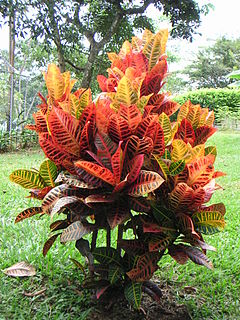
Codiaeum variegatum is a species of plant in the genus Codiaeum, which is a member of the family Euphorbiaceae. It was described by Carl Linnaeus in 1753. It is native to Indonesia, Malaysia, Australia, and the western Pacific Ocean islands, growing in open forests and scrub.

Hyaloperonospora is a genus of oomycete, obligate, plant pathogens that was originally considered to be part of Peronospora. Species in this group produce a disease called downy mildew and can infect many important crops. From the 19 downy mildew producing genera, Hyaloperonospora has been grouped with Perofascia in the brassicolous downy mildews. In the group of downy mildews, Hyaloperonospora is the third biggest genus. The most famous species in the genus is the Hyaloperonospora parasitica, or also known as Hyaloperonospora arabidopsis. This species has become a model organism from its ability to infect the model plant Arabidopsis thaliana. It is used to study plant-pathogen interactions, and is currently the only Hyaloperonospora species that has an assembled genome.

Peronospora is a genus of oomycetes that are obligate plant pathogens of many eudicots. Most species in this group produce a downy mildew disease, which can cause severe damage to many different cultivated crops, as well as wild and ornamental plants. There are 19 genera that produce downy mildew, and Peronospora has been placed alongside Pseudoperonospora in the group of downy mildews with coloured conidia. Peronospora has far more species than any other genus of the downy mildews. However, many species have been moved from this genus to be reclassified to other or new genera. Among these was the most famous Peronospora species, formerly known as Peronospora parasitica, and now known as Hyaloperonospora parasitica. Now, the Peronospora species of most importance is likely the Peronospora tabacina. Peronospora tabacina causes blue mold on tobacco plants and can severely reduce yields of this economically important crop to the point where it has been classified as a bioweapon.
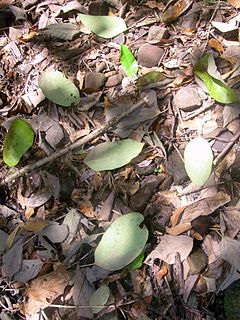
Litterfall, plant litter, leaf litter, tree litter, soil litter, or duff, is dead plant material that have fallen to the ground. This detritus or dead organic material and its constituent nutrients are added to the top layer of soil, commonly known as the litter layer or O horizon. Litter is an important factor in ecosystem dynamics, as it is indicative of ecological productivity and may be useful in predicting regional nutrient cycling and soil fertility.

Excoecaria agallocha, a mangrove species, belongs to the genus Excoecaria of the family Euphorbiaceae. The species has many common names, including blind-your-eye mangrove, blinding tree, buta buta tree, milky mangrove, poisonfish tree, and river poison tree. Most of the names refer to its toxic properties or its propensity to cause blindness when its latex comes into contact with the eyes.
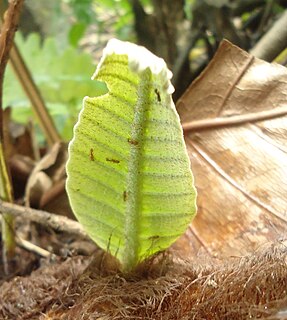
Tritrophic interactions in plant defense against herbivory describe the ecological impacts of three trophic levels on each other: the plant, the herbivore, and its natural enemies. They may also be called multitrophic interactions when further trophic levels, such as soil microbes or hyperparasitoids are considered. Tritrophic interactions join pollination and seed dispersal as vital biological functions which plants perform via cooperation with animals.
Melanolepsis multiglandulosa is a plant species of the family Euphorbiaceae, first described in 1826. It is native to Nansei-shoto, Mariana Islands, Solomon Islands, Bismarck Archipelago, New Guinea, Maluku, Sulawesi, Philippines, Lesser Sunda Islands, Java, Sumatra, Borneo, Thailand, Malaysia and Taiwan.
Plukenetia conophora, also called Nigerian walnut, and conophore, is a climbing shrub in the genus Plukenetia. It is not related to the walnut, being so named because its nuts bear a superficial resemblance to the walnut. It is native to tropical western and central Africa from Togo to Congo and in Sierra Leone. It is abundant in the Nigeria, Cameroon, Republic of the Congo and Democratic Republic of Congo. It prefers rain-forest hedge in half-shady places; low bush; secondary forest; plantations at elevations from 250–1,400 m (820–4,590 ft). Although it is well recorded in Sierra Leone, it is apparently not indigenous to Sierra Leone, since it is not recorded in Liberia and Ghana. Its presence in Sierra Leone is due to returning slaves for it is known to the Krio by its Yoruba (Nigerian) name. Plukenetia conophora is the only Plukenetia species native to West Africa or Central Africa. Other Plukenetia species are indigenous to other parts of Africa, the Indian Subcontinent, Southeast Asia, and America.

Macaranga trichocarpa is a species of Asian small trees in the family Euphorbiaceae and tribe Acalypheae, found especially in secondary tropical forests. No subspecies are listed in the Catalogue of Life and the recorded distribution includes Indo-China and western Malesia, including Borneo.

Macaranga denticulata is a species of Asian small trees in the family Euphorbiaceae and tribe Acalypheae, found especially in secondary tropical forests. No subspecies are listed in the Catalogue of Life and the recorded distribution includes: India, southern China, Indo-China and western Malesia.
Mark Westoby is an Australian evolutionary ecologist, Emeritus Professor at Macquarie University, a specialist in trait ecology.

Phyllanthus fluitans, also known as the red root floater, floating spurge, or apple duckweed is a species of free floating aquatic plant and herbaceous perennial in the family Phyllanthaceae. This species is one of the only three non-terrestrial species in the genus Phyllanthus, with the other species being P. leonardianus and P. felicis. The generic name comes from Ancient Greek meaning leaf or a leaf flower, and the specific name comes from Latin meaning floating or float. It was described in Mar 1863 by George Bentham and Johannes Müller Argoviensis.














